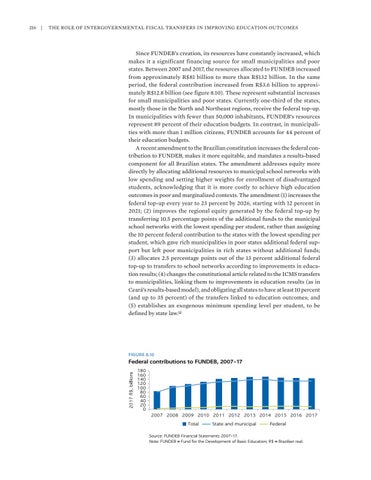216 | The Role of Intergovernmental Fiscal Transfers in Improving Education Outcomes
Since FUNDEB’s creation, its resources have constantly increased, which makes it a significant financing source for small municipalities and poor states. Between 2007 and 2017, the resources allocated to FUNDEB increased from approximately R$81 billion to more than R$132 billion. In the same period, the federal contribution increased from R$3.6 billion to approximately R$12.8 billion (see figure 8.10). These represent substantial increases for small municipalities and poor states. Currently one-third of the states, mostly those in the North and Northeast regions, receive the federal top-up. In municipalities with fewer than 50,000 inhabitants, FUNDEB’s resources represent 89 percent of their education budgets. In contrast, in municipalities with more than 1 million citizens, FUNDEB accounts for 44 percent of their education budgets. A recent amendment to the Brazilian constitution increases the federal contribution to FUNDEB, makes it more equitable, and mandates a results-based component for all Brazilian states. The amendment addresses equity more directly by allocating additional resources to municipal school networks with low spending and setting higher weights for enrollment of disadvantaged students, acknowledging that it is more costly to achieve high education outcomes in poor and marginalized contexts. The amendment (1) increases the federal top-up every year to 23 percent by 2026, starting with 12 percent in 2021; (2) improves the regional equity generated by the federal top-up by transferring 10.5 percentage points of the additional funds to the municipal school networks with the lowest spending per student, rather than assigning the 10 percent federal contribution to the states with the lowest spending per student, which gave rich municipalities in poor states additional federal support but left poor municipalities in rich states without additional funds; (3) allocates 2.5 percentage points out of the 13 percent additional federal top-up to transfers to school networks according to improvements in education results; (4) changes the constitutional article related to the ICMS transfers to municipalities, linking them to improvements in education results (as in Ceará’s results-based model), and obligating all states to have at least 10 percent (and up to 35 percent) of the transfers linked to education outcomes; and (5) establishes an exogenous minimum spending level per student, to be defined by state law.13
FIGURE 8.10
2017 R$, billions
Federal contributions to FUNDEB, 2007–17 180 160 140 120 100 80 60 40 20 0 2007 2008 2009 2010 2011 2012 2013 2014 2015 2016 2017 Total
State and municipal
Federal
Source: FUNDEB Financial Statements 2007–17. Note: FUNDEB = Fund for the Development of Basic Education; R$ = Brazilian real.






